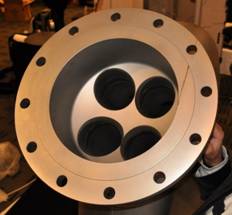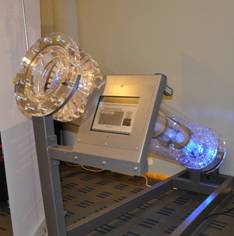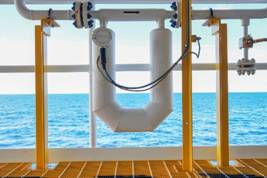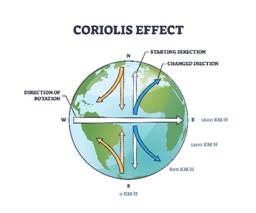|
Larger Line Size
-A Frontier of research for Coriolis.
Building large and larger line size Coriolis
flow meters is a frontier of research for this meter type. The largest line
size currently built is a 16-inch meter built by Endress+Hauser. It is not
clear why a larger Coriolis meter cannot be built, but such a meter would
have to overcome several barriers:

- The meter would presumably have to be even
larger and heavier than the current large line size meters. This would make
it even more difficult to move around and install than existing meters. So
far no one has been able to build a 20 inch meter.
- As the meter gets larger, it becomes more
difficult to vibrate the meter in such a way that it can reliably indicate
mass flow. This is due to the increased weight of the meter.
- Any meter that is larger than the existing
meters would be even more expensive than the existing line size meters,
some at which sell for $75,000. End-users would likely look for an
alternative technology such as ultrasonic or turbine if these other meters
could satisfy their needs for considerably less cost.
(from New-Technology Flowmeters, a new book
by Dr. Jesse Yoder that was published on September 6th, 2022 by Taylor
& Francis)
One possible way this problem can be
approached is by using even lighter materials of construction for the
flowtubes. This would facilitate the vibration of the meter and also make
it lighterCoriolis flowmeters are a relatively recent entrant into the
market. Although the roots of today’s Coriolis flowmeters can be traced
back to the 1950s, it was not until 1977 that Micro Motion introduced a
commercially viable Coriolis flowmeter for industrial applications. Since
that time, a number of other suppliers have entered the market, including
Endress+Hauser and KROHNE.
The principle underlying the
Coriolis flowmeter, however, dates back to 1835, when French mathematician
Gustave Coriolis showed that an inertial force needs to be taken into
account when describing the motion of bodies in a rotating frame of
reference. A hypothetical object thrown from the North Pole to the
equator, for example, appears to vary from its intended path due to the
earth’s rotation -- and this illustrates the Coriolis force.
Learn more
about New Technology Flowmeters:

Why
Measure Mass Flow?
While
in many cases volumetric flow is sufficient, it is also desirable at times
to measure mass flow. Many
products are sold by weight rather than by volume, and in these cases it is
often desirable to measure mass flow. Chemical
reactions are often based on mass rather than volume, so mass flow
measurement is often required in the chemical industry.
While
both volumetric and mass flow apply to liquids and gases, mass flow is
especially appropriate for measuring gases.
This is because gases are much more affected by temperature and
pressure than are liquids. Pressure
has minimal effect on liquids in terms of compressibility and is often
ignored in making volumetric measurements of flow.
The effects of temperature on liquids are also often disregarded,
except where high accuracy is desired.
Operating
Principle
 Modern
Coriolis flowmeters today typically consist of one or two vibrating tubes
with an inlet and an outlet. These
tubes can either be straight or bent, though the large majority are bent.
Whether they are single or dual, bent or straight, Coriolis
flowmeters rely on oscillating tubes. The
tubes are made to oscillate at their natural resonant frequency by an
electromagnetic exciter or drive coil located at the apex of the tubes.
The apex is the highest point of the tube, and it is where the inlet
ends, and the outlet begins. Another
way of describing the apex is that it is the central point between the
beginning of the tube and the end of the tube. Modern
Coriolis flowmeters today typically consist of one or two vibrating tubes
with an inlet and an outlet. These
tubes can either be straight or bent, though the large majority are bent.
Whether they are single or dual, bent or straight, Coriolis
flowmeters rely on oscillating tubes. The
tubes are made to oscillate at their natural resonant frequency by an
electromagnetic exciter or drive coil located at the apex of the tubes.
The apex is the highest point of the tube, and it is where the inlet
ends, and the outlet begins. Another
way of describing the apex is that it is the central point between the
beginning of the tube and the end of the tube.
The
peak amplitude of vibration is at the apex of the flow tube or tubes.
Magnet
and coil assemblies called pickoffs are mounted at the same corresponding
place on the inlet and the outlet portions of the flow tube(s).
As the tubes oscillate, the voltage generated from each pickoff
creates a sine wave. When there
is no flow, the inlet and outlet sine waves are in phase.
Being in phase means that they are in a synchronized motion.
The peak amplitude of vibration is at the apex of the flow
tube or tubes. Coriolis
flowmeters have a pickoff coil on the inlet side and the outlet side of the
flow tube. The pickoff contains
a coil and a magnet. As the
coil moves through the magnetic field from the vibration of the tubes,
voltage is produced. This
voltage can be represented as a sine wave.
When fluid is not moving through the tube, the inlet and
outlet sine waves are in phase. Being
in phase means that they are in a synchronized motion.
This means that the waves are moving at
the same rate and exactly together. When
two people synchronize their watches, they set them
to the same time so that the watches are moving together, and both tell the
same time. Under
no flow conditions, the size waves generated by the pickoffs on the inlet
and outlet side look exactly the same.
When fluid moves through the tube, the inertial force of the
fluid causes the tube to oscillating. This
results in a phase shift, or time difference, between the sine waves on the
inlet side of the tube and the sine waves on the outlet side of the tube.
The sine waves generated by the pickoff coils on the inlet and
outlet side of the tube are no longer in phase; instead, they are
asynchronous. There is now a
difference in time between these sine waves, which is measured in
microseconds. This difference
in time is called delta t. Delta
t is directly proportional to mass flowrate.
The mass flowrate is computed by the transmitter, which outputs this
value along with other desired values such as density, volumetric flow, and
temperature.
While the amount of the phase shift or delta t is directly
proportional to mass flowrate, the sine wave frequency indicates density.
Frequency means the number of waves per second.
A heavy fluid like honey will have a lower frequency than a lighter
liquid such as water. Some
Coriolis meters are used to measure density rather than flow, but generally
both values are desired.
Coriolis
flowmeter design
Coriolis
flowmeters contain one or more vibrating tubes. These tubes are
usually bent, although straight-tube meters are also available. The
fluid to be measured passes through the vibrating tubes. It
accelerates as it flows toward the maximum vibration point and slows down
as it leaves that point. This causes the tubes to twist. The
amount of twisting is directly proportional to mass flow. Position
sensors detect tube positions.
Coriolis
suppliers have introduced a wide variety of models and types of Coriolis
flowmeters in the past 35+ years and differentiate themselves in a number
of ways. One is by the proprietary design of the bent tubes. Another
is by the different types of straight tube Coriolis flowmeters they offer.
Suppliers also
compete by bringing out Coriolis flowmeters for particular industries and
applications, such as food & beverage and pharmaceutical. Accuracy
and other performance specifications are other areas of supplier
differentiation.
 While Coriolis
flowmeters are loved by many end users, price is often an issue. Coriolis
flowmeters are the most expensive meter made, in terms of average selling
price. The average selling price of Coriolis flowmeters are
between $5,000 and $6,000. Some suppliers have introduced
low-cost Coriolis flowmeters in the $3,000 range. Performance
specifications for the lower-cost flowmeters are not at the same level as
those of the higher-priced meters. However, these lower-cost
meters can help satisfy the needs of users who want the essential benefits
of Coriolis technology but prefer not to pay the higher price. While Coriolis
flowmeters are loved by many end users, price is often an issue. Coriolis
flowmeters are the most expensive meter made, in terms of average selling
price. The average selling price of Coriolis flowmeters are
between $5,000 and $6,000. Some suppliers have introduced
low-cost Coriolis flowmeters in the $3,000 range. Performance
specifications for the lower-cost flowmeters are not at the same level as
those of the higher-priced meters. However, these lower-cost
meters can help satisfy the needs of users who want the essential benefits
of Coriolis technology but prefer not to pay the higher price.
Coriolis
flowmeters are used to measure both liquids and gases, but they do have
some limitations with gas flows. Coriolis meters have an easier time
measuring liquids than gases because liquids are denser than gases.
Advantages and
disadvantages of Coriolis flowmeters
|
Advantages
|
Disadvantages
|
|
High accuracy
|
High initial cost
|
|
Approved for custody transfer for liquid and gas
applications
|
Becomes expensive and unwieldy in line sizes
above four inches
|
|
Now available for line sizes above six inches
|
Gas flow measurement can be difficult due to low
density of gas
|
|
Can handle sanitary applications
|
Pressure drop for bent-tube meters
|
|
Excel in line sizes of two inches and less
|
Can have a problem measuring liquids with
entrained gas
|
|
High reliability, low maintenance
|
|
|
Much new product development ongoing
|
|
Flow Research
previously published Coriolis studies in 2001, 2003, 2008, 2013, 2016 and
2020. For further information on Coriolis meters and our detailed market
reports, please visit www.FlowCoriolis.com.
Another
look at the Coriolis principle of operation - by Jesse Yoder
 For many years, I've questioned why Coriolis flowmeters are
called "Coriolis" meters. I even wrote an article for Flow
Control in 2011 arguing they should be called "inertial mass
meters," and discussing whether they embody the Coriolis principle.
You can read the article at www.flowarticles.com. For many years, I've questioned why Coriolis flowmeters are
called "Coriolis" meters. I even wrote an article for Flow
Control in 2011 arguing they should be called "inertial mass
meters," and discussing whether they embody the Coriolis principle.
You can read the article at www.flowarticles.com.
I've discussed this with the top engineers
and designers at the leading Coriolis companies in the US, UK, and
Switzerland. I have even had discussions with colleagues from Germany who
have spent 25 years designing these meters. These are the main points
discussed.
1. It is believed that Coriolis meters
employ a force that governs the behavior of bodies in a rotational frame of
reference. This is sometimes called a Coriolis force.
2. Coriolis meters do not employ the "Coriolis
effect," which has to do with the observed deflection of a body moving
over a rotating platform. This is what Gustave Coriolis was referring to
when he wrote about storms being deflected as they move north from the
equator.
3. Once you remove the Coriolis effect from
the equation, there is no longer any reason to call the meters "Coriolis"
meters. Perhaps "oscillating meters" would be more accurate.
This is something I've struggled with for
over 10 years and now at last, I see a solution!
To clarify, Coriolis meters are the most
accurate meter made and they solve a lot of flow problems that other meters
don't. I'm not saying we should change their name. I am saying that
Coriolis meters don't make use of the Coriolis effect.
This has been dubbed a "Coriolis
force" by people like Yao Tzu Li who patented an early version of this
meter in 1960 and by Anatole Sipin who has 3 patents in the 1960s. This
terminology was picked up by dozens of later patents. The problem is that
Gustave Coriolis was talking about a "fictitious" force that was
described after his death (1843) as the Coriolis effect. It refers to the
apparent effect on the motion of an object passing over a rotating frame of
reference when viewed from the perspective pf the point of origin that
moving object. The force exerted by the oscillating tubes of a Coriolis
meter on the fluid is a real force, but it is due to the fluid movement
along a small portion of a circle. It is unrelated to Gustave's Coriolis
effect.
For more information on Coriolis
flowmeters, see New-Technology flowmeters a new book from CRC press,
available at New-Technology Flowmeters: Volume I, Yoder, Jesse, eBook - Amazon.com.
The attached picture is the first page of
Gustave Coriolis’ 1835 Memoir on the Relative Motion of Bodies,
translated in 2022 for the first time from French to English by Flow
Research.
|